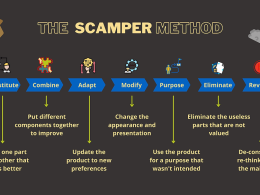Table of Contents Show
Having a strong unique selling proposition (USP) is crucial for any business wanting to stand out amongst the competition. Your USP communicates what makes your company, product, or service unique and why customers should purchase from you rather than a competitor. An effective USP can boost brand awareness, improve conversion rates, and help you attract more loyal customers.
In this comprehensive guide, we’ll walk through the key steps for crafting a compelling and memorable USP that resonates with your target audience.
Why Your Business Needs a Unique Selling Proposition
Before diving into how to create your USP, it’s important to understand why having one is so critical for business success. Here are some of the key benefits of developing a robust unique selling proposition:
- Distinguishes you from competitors: An effective USP highlights what makes your business different and better. This differentiation is key for getting noticed by potential customers.
- Communicates core value: Your USP conveys the core value or “proposition” you offer to consumers. It sums up the primary reason they should buy from you.
- Builds trust and credibility: A USP provides proof that your product or service delivers on its promises and has unique advantages. This establishes credibility and trust.
- Increases conversions: By clearly communicating your key differences and benefits, a strong USP persuades more prospects to become customers.
- Enhances brand loyalty: Customers who resonate with your USP are more likely to choose you over competitors again and again.
- Guides marketing efforts: Your USP gives you a north star to guide and inform all marketing campaigns and messaging.
Without a USP, your brand is essentially invisible amongst the sea of competitors. You need something that makes you “pop” and motivates purchase decisions. That’s where establishing a unique selling proposition comes in.
How to Develop a Unique Selling Proposition (USP)
Now let’s explore the step-by-step process for creating a compelling and effective USP for your business.
Understand Your Target Audience
The first step is gaining a deep understanding of who your ideal customers are. What are their demographics, needs, behaviors, values, and desires? Building buyer personas can help uncover this information. Some key questions to ask:
- What problem are they trying to solve?
- What benefits are most appealing to them?
- How do they make purchasing decisions?
- What motivates or discourages them from buying?
Thorough market research provides insights you can leverage to craft messaging that truly resonates with your audience.
Analyze Your Competition
Conducting a competitive analysis is equally important. Learn what your competitors’ USPs are and how they position themselves in the marketplace.
- What makes them unique?
- What language and messaging do they use?
- Where do they lack or fall short?
Carefully evaluate their strengths and weaknesses. This reveals opportunities for you to set yourself apart from the pack. Lean into areas where competitors are not delivering while positioning your USP to fill gaps in the market.
Identify Your Strengths and Competitive Advantages
Now it’s time to define what makes you special. Assess your company’s core strengths, capabilities, and competitive advantages. Some questions to ask:
- What do we do better than anyone else?
- How are our products or services superior?
- What value do we provide that competitors do not?
- Why are customers loyal to our brand?
Uncover the top benefits and differentiators you can leverage in your USP. For example, niche expertise, bespoke offerings, better quality, or excellent customer service.
Craft Your USP Statement
With a firm grasp on your audience, competitors, and own strengths, start crafting a unique selling proposition statement.
Your USP should be:
- Concise: Keep it short, usually less than 15 words.
- Clear: Use simple, direct language that is easy to grasp.
- Focused: Zero in on your biggest differentiator.
- Benefit-driven: Emphasize value, not just features. Talk about outcomes customers get.
- Credible: Provide proof points on why you’re better or different.
- Memorable: Use compelling phrases and vivid language.
For example:
“Bespoke luxury watches at an affordable price“
This USP highlights niche expertise, competitive pricing, and premium quality in just six words.
Take time to craft and refine your statement. Test different variations with target audiences to determine what resonates most.
Design an Attention-Grabbing Brand Identity
With your USP defined, ensure your brand identity aligns with and reinforces it visually.
Branding elements like your logo, typography, color scheme, and imagery should reflect what makes your business unique. This creates cohesion across the customer journey.
For example, an eco-friendly company may use green hues and natural imagery. A tech company may opt for a sleek, minimalist look.
Your website, product packaging, marketing materials, and assets across social platforms should all tie back to your USP. This repetition cements it in audience’s minds.
Develop Compelling, Value-Driven Content
Content marketing presents a prime opportunity to communicate your unique value and perspective to audiences.
Create content that provides value and aligns with your USP, such as:
- Blog posts showcasing your expertise.
- eBooks or guides that educate readers.
- Videos demonstrating your product/service.
- Webinars with actionable takeaways.
Focus on addressing audience needs and highlighting differentiators, not overt promotion. For example, an HR software company could publish guides on leadership development or videos on improving employee retention.
Use content to tell your brand’s story in an authentic way. The goal is to organically attract and engage your ideal customers.
Once you’ve created valuable content, social media is the perfect channel for sharing it at scale.
Develop a strategic presence on platforms where your audience is most active, such as Facebook, Instagram, Twitter, LinkedIn, YouTube, TikTok, etc. Use social networks to:
- Establish thought leadership: Share insights, perspectives, and trends.
- Engage followers: Reply to comments, post intriguing questions, run polls.
- Promote content: Drive traffic to your website and blog.
- Showcase products in action: Post demos, “how-to” videos, user-generated content.
- Run ads: Promote content and offers aligned with your USP.
Strategic social media marketing expands your reach exponentially and gets your unique proposition in front of key audiences.
Optimize Website Copy to Communicate Your USP
Your website is often the first touchpoint between prospects and your brand. Ensure copy and messaging clearly conveys your USP.
- Hero sections should feature your proposition prominently.
- Page headlines and opening paragraphs emphasize your difference.
- Product/service descriptions highlight your unique benefits and value.
- About Us page tells your brand origin story and why you’re one-of-a-kind.
Compelling copy entices visitors to engage further and learn more about what you offer.
Track Performance Metrics to Assess Effectiveness
Finally, implement analytics to monitor how well your USP is performing. Key metrics include:
- Sales or conversion rates
- Website traffic from organic search and referrals
- Bounce rates
- Social engagement levels
These provide quantifiable data on how your USP resonates with audiences. Tweak messaging or strategy based on what performs well.
USP Examples From Top Brands
Let’s look at some stellar USP examples from successful companies across industries:
- Domino’s: “Hot pizza delivered in 30 minutes or less.”
This emphasizes speedy delivery, setting them apart from competitors.
- Dollar Shave Club: “Premium razors and grooming gear for just a few bucks.”
They focus on top-notch quality at budget-friendly pricing.
- Mailchimp: “Send better email. Sell more stuff.”
In just seven words, Mailchimp establishes themselves as the best email marketing solution for driving sales.
- HubSpot: “Make every part of your business better with inbound marketing.”
Their USP spells out how they uniquely improve operations through inbound techniques.
- Slack: “Where work happens.”
Their proposition focuses on streamlined team communication in the workplace.
These real-world examples demonstrate how leading companies craft USPs that instantly communicate their competitive edge. Let them inspire you to create a memorable statement for your own business!
Crafting an FAQ USP Section
Including a “Frequently Asked Questions” section on your website is another excellent way to highlight your USP to potential customers. Here are some tips for creating a compelling FAQ page aligned with your unique proposition:
Use questions your customers actually ask:
- What makes your product/service different?
- Why should I choose your business over a competitor?
- How do you guarantee quality?
Answer questions in ways that reinforce your USP:
- Our handcrafted approach to xyz sets us apart…
- Our 100% satisfaction guarantee ensures you receive the best service…
- As the leading provider of xyz, we only use premium materials…
Add visuals like logos, charts, or product photos to help convey what’s unique about your business.
Optimize with relevant keywords so the FAQ content is easily discoverable.
An FAQ page allows you to directly address prospects’ concerns and communicate how you deliver unmatched value – improving conversions.
Here are examples of FAQ questions/answers focused on USPs:
Q: Why should I buy from you vs. Amazon or other big retailers?
A: We meticulously inspect each product for defects to ensure it meets our stringent quality standards. You receive personalized service and support from our product experts too.
Q: How is your shipping different than other meal kit services?
A: Our patent-pending cold chain packaging keeps pre-made meals fresh and flavourful in transit. Meals arrive ready to heat and enjoy without any compromises in quality or taste.
Q: What makes your boutique hotel stand out from large chain hotels?
A: Our cozy, boutique atmosphere offers a one-of-a-kind experience you can’t find at crowded chain hotels. You’ll enjoy personalized service plus luxurious amenities and touches.
Conclusion
Establishing a strong, unique selling proposition is one of the most impactful steps you can take to boost your brand and drive conversions. Summarize what makes you special, focus on tangible customer benefits, and communicate your competitive difference across every touchpoint. Learn your audience, refine your message, and reinforce consistency.
With an effective USP that resonates with your market, you can expand awareness, improve sales, and ultimately grow your business. Don’t wait to establish your unique proposition and competitive edge!
Frequently Asked Questions
What are some tips for writing a catchy unique selling proposition?
Some tips for crafting a catchy and memorable unique selling proposition include:
- Keep it simple – Opt for clear, concise language that is easy to grasp. Avoid overly complex or verbose statements.
- Focus on the benefit – Emphasize the outcome or advantage customers get from your product/service.
- Add intrigue – Use interesting phrases like “for the first time ever” or “never before seen” to pique interest.
- Rhyme or repeat words – This makes your USP more catchy and unforgettable.
- Use the rule of three – Three benefits, features, or reasons are ideal for sticking in customers’ minds.
- Add urgency – Phrases like “for a limited time only” can motivate quicker conversions.
- Leverage your brand personality – Let your USP reflect your brand’s voice, tone, and uniqueness.
How often should you update your unique selling proposition?
It’s a good idea to re-evaluate and update your unique selling proposition every 6 to 12 months. This ensures your USP stays current as your business evolves or market conditions change.
Signs it may be time for an update include:
- Launching new products or services
- Improving capabilities or offerings
- Identifying new competitive advantages
- Targeting a new customer segment
- Competitors copying your current USP
- Poor conversion or engagement rates on marketing campaigns
While you don’t want to change your core USP frequently, regular tuning and refining allows you to maximize its effectiveness as your business grows.
How can I test variations of my USP to see what resonates most?
Some tips for testing different versions of your USP include:
- Split test on your website – Show a control vs. variant to a portion of site visitors and see which drives more conversions.
- Run A/B tests on landing pages – Direct traffic sources to different pages with unique USPs.
- Survey target audiences – Get feedback directly from customers on messaging options.
- Try different wording in ads – Test USP language and track engagement on social promotions.
- Alter in email campaigns – Send version A to half your list and version B to the other half.
- Rotate on packaging – Use unique propositions on product packaging in batches.
- Analyze performance data – See which USP has the highest clickthrough, conversion, or sales rates.
- Gather customer feedback – Ask for reviews on what resonates about your messaging.
Testing allows you to refine your USP for maximum impact on conversions and sales.
How can I ensure my USP stays consistent across channels?
To maintain USP consistency across marketing channels:
- Create brand guidelines – Document details like approved phrasing, logo use, fonts, colors, and visual style.
- Establish processes – Ensure any new materials are reviewed/approved by one owner.
- Use brand asset libraries – Store approved logos, images, graphics in a central hub.
- Conduct audits – Periodically review touchpoints and check for consistency.
- Train team members – Educate staff on correct USP usage and guidelines.
- Leverage marketing automation – Sync messaging across platforms through linked systems.
- Monitor analytics – Identify any channels/campaigns where USP isn’t aligning.
- Update gradually – Roll out minor USP tweaks slowly vs. dramatic shifts.
Consistency strengthens recognition and trust in your brand. It also amplifies the impact of your unique proposition across the entire customer journey.







